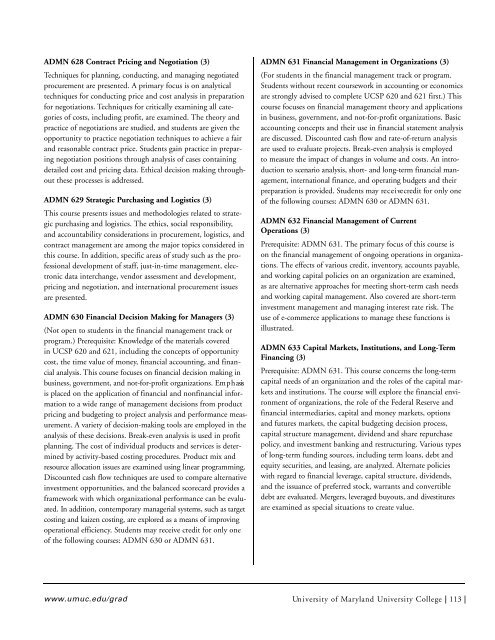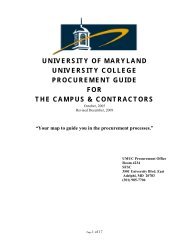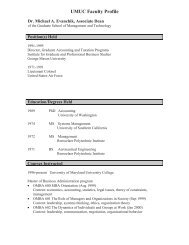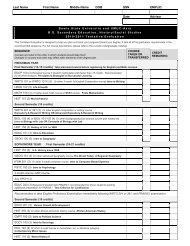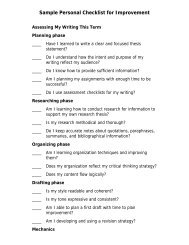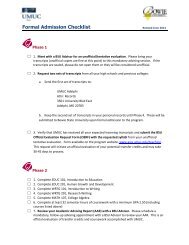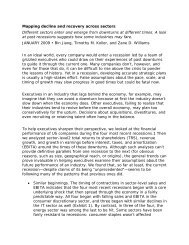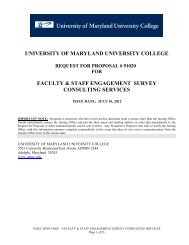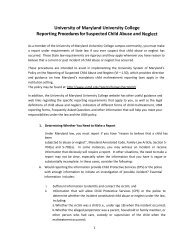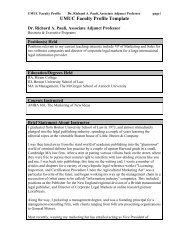A+B. Intro_SJ.1 - University of Maryland University College
A+B. Intro_SJ.1 - University of Maryland University College
A+B. Intro_SJ.1 - University of Maryland University College
Create successful ePaper yourself
Turn your PDF publications into a flip-book with our unique Google optimized e-Paper software.
ADMN 628 Contract Pricing and Negotiation (3)<br />
Techniques for planning, conducting, and managing negotiated<br />
procurement are presented. A primary focus is on analytical<br />
techniques for conducting price and cost analysis in preparation<br />
for negotiations. Techniques for critically examining all categories<br />
<strong>of</strong> costs, including pr<strong>of</strong>it, are examined. The theory and<br />
practice <strong>of</strong> negotiations are studied, and students are given the<br />
opportunity to practice negotiation techniques to achieve a fair<br />
and reasonable contract price. Students gain practice in preparing<br />
negotiation positions through analysis <strong>of</strong> cases containing<br />
detailed cost and pricing data. Ethical decision making throughout<br />
these processes is addressed.<br />
ADMN 629 Strategic Purchasing and Logistics (3)<br />
This course presents issues and methodologies related to strategic<br />
purchasing and logistics. The ethics, social responsibility,<br />
and accountability considerations in procurement, logistics, and<br />
contract management are among the major topics considered in<br />
this course. In addition, specific areas <strong>of</strong> study such as the pr<strong>of</strong>essional<br />
development <strong>of</strong> staff, just-in-time management, electronic<br />
data interchange, vendor assessment and development,<br />
pricing and negotiation, and international procurement issues<br />
are presented.<br />
ADMN 630 Financial Decision Making for Managers (3)<br />
(Not open to students in the financial management track or<br />
program.) Prerequisite: Knowledge <strong>of</strong> the materials covered<br />
in UCSP 620 and 621, including the concepts <strong>of</strong> opportunity<br />
cost, the time value <strong>of</strong> money, financial accounting, and financial<br />
analysis. This course focuses on financial decision making in<br />
business, government, and not-for-pr<strong>of</strong>it organizations. Em p h asis<br />
is placed on the application <strong>of</strong> financial and nonfinancial information<br />
to a wide range <strong>of</strong> management decisions from product<br />
pricing and budgeting to project analysis and performance measurement.<br />
A variety <strong>of</strong> decision-making tools are employed in the<br />
analysis <strong>of</strong> these decisions. Break-even analysis is used in pr<strong>of</strong>it<br />
planning. The cost <strong>of</strong> individual products and services is determined<br />
by activity-based costing procedures. Product mix and<br />
re s o u rce allocation issues are examined using linear pro g r a m m i n g .<br />
Discounted cash flow techniques are used to compare alternative<br />
investment opportunities, and the balanced scorecard provides a<br />
framework with which organizational performance can be evaluated.<br />
In addition, contemporary managerial systems, such as target<br />
costing and kaizen costing, are explored as a means <strong>of</strong> improv i n g<br />
operational efficiency. Students may receive credit for only one<br />
<strong>of</strong> the following courses: ADMN 630 or ADMN 631.<br />
ADMN 631 Financial Management in Organizations (3)<br />
(For students in the financial management track or program.<br />
Students without recent coursework in accounting or economics<br />
are strongly advised to complete UCSP 620 and 621 first.) This<br />
course focuses on financial management theory and applications<br />
in business, government, and not-for-pr<strong>of</strong>it organizations. Basic<br />
accounting concepts and their use in financial statement analysis<br />
are discussed. Discounted cash flow and rate-<strong>of</strong>-return analysis<br />
are used to evaluate projects. Break-even analysis is employed<br />
to measure the impact <strong>of</strong> changes in volume and costs. An introduction<br />
to scenario analysis, short- and long-term financial management,<br />
international finance, and operating budgets and their<br />
preparation is provided. Students may re c e i ve credit for only one<br />
<strong>of</strong> the following courses: ADMN 630 or ADMN 631.<br />
ADMN 632 Financial Management <strong>of</strong> Current<br />
Operations (3)<br />
Prerequisite: ADMN 631. The primary focus <strong>of</strong> this course is<br />
on the financial management <strong>of</strong> ongoing operations in organizations.<br />
The effects <strong>of</strong> various credit, inventory, accounts payable,<br />
and working capital policies on an organization are examined,<br />
as are alternative approaches for meeting short-term cash needs<br />
and working capital management. Also covered are short-term<br />
investment management and managing interest rate risk. The<br />
use <strong>of</strong> e-commerce applications to manage these functions is<br />
illustrated.<br />
ADMN 633 Capital Markets, Institutions, and Long-Term<br />
Financing (3)<br />
Prerequisite: ADMN 631. This course concerns the long-term<br />
capital needs <strong>of</strong> an organization and the roles <strong>of</strong> the capital markets<br />
and institutions. The course will explore the financial environment<br />
<strong>of</strong> organizations, the role <strong>of</strong> the Federal Reserve and<br />
financial intermediaries, capital and money markets, options<br />
and futures markets, the capital budgeting decision process,<br />
capital structure management, dividend and share repurchase<br />
policy, and investment banking and restructuring. Various types<br />
<strong>of</strong> long-term funding sources, including term loans, debt and<br />
equity securities, and leasing, are analyzed. Alternate policies<br />
with regard to financial leverage, capital structure, dividends,<br />
and the issuance <strong>of</strong> preferred stock, warrants and convertible<br />
debt are evaluated. Mergers, leveraged buyouts, and dive s t i t u re s<br />
are examined as special situations to create value.<br />
w w w. u m u c . e d u / g r a d<br />
Un i versity <strong>of</strong> Ma r yland Un i versity <strong>College</strong> | 113 |


